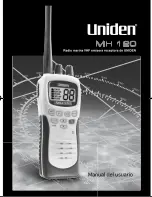
32
English
3) RF GAIN:
This knob is for adjusting sensitivity during reception. For long distance communica-
tions RF GAIN should be set to maximum. RF GAIN can be reduced to avoid distortion,
when your correspondent is close by and who does not have the RF POWER function.
The normal setting of this knob is on maximum (fully clockwise).
4) CHANNEL SELECTOR ROTARY KNOB:
Turning this knob allows you to choose a channel (1-40) for transmitting and receiving.
5) DISPLAY:
The display shows all the different functions. The bargraph shows the level of
reception and the level of power emitted. The TX LED lights up when the set goes into
transmission mode.
6) FREQUENCY BAND SELECTION
The frequency bands must be chosen according to the country where you are going
to operate. Do not use another configuration. Some countries require user’s licence.
a)
Radio set switched OFF.
b)
Slide the
F/OFF
switch on
F
position.
c)
Switch ON the radio.
d)
Choose the request configuration with the channel rotary switch (see the chart p. 50).
e)
Slide the
F/OFF
switch on
OFF
position.
f)
And then, for final confirmation of the choice before operating in the configuration,
switch OFF then ON the radio set.
7) MODE:
Use this key to select AM or FM. The modulation mode must correspond with that of
the person with whom you communicate.
AM/
Amplitude Modulation (AM) is for communications in areas where there are
obstacles and over medium distances.
FM/
Frequency Modulation (FM) is for nearby communications in flat, open areas. It
gives better quality of communication (squelch adjustment needs more finesse).
8) CH 19:
Channel 19 is automatically selected when you activate this switch. To activate this
function, move the switch to
CH19
position, and to return to the previous channel
move the same switch to
OFF
position.
9) 6-PIN MICROPHONE PLUG:
This plug is situated on the front panel, thereby making it easier to set the equipment
into the dashboard. See the cabling diagram on page 49.
10) PTT (push to talk):
Depress this knob to transmit a message and release to listen to an incoming
communication.
A) DC-POWER TERMINAL (13,2 V)
B) ANTENNA CONNECTOR (SO-239)
C) EXTERNAL SPEAKER JACK (8
Ω
Ω
Ω
Ω
Ω
, Ø 3,5 mm)




































